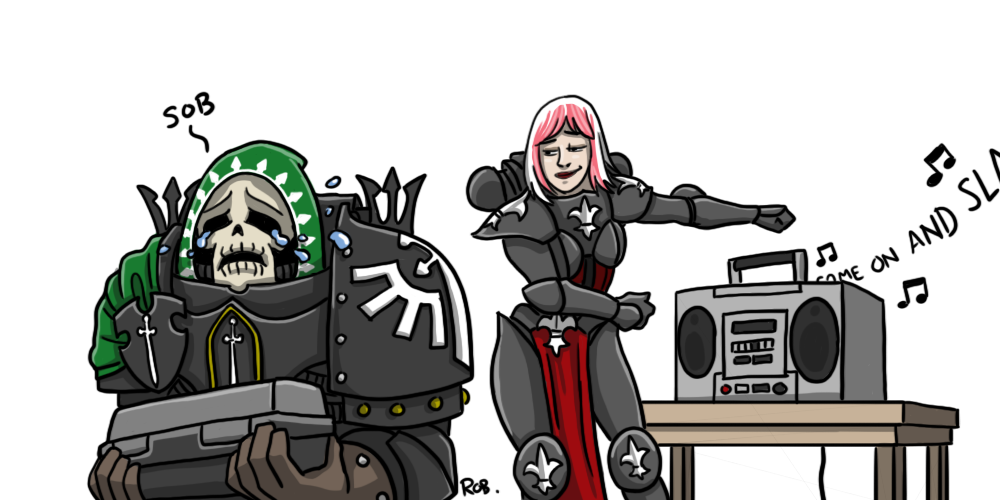In these difficult times, a good way to stay cheerful is to pick some sort of ambitious project to work on in your hobby time, especially if you’ve suddenly got a lot more of it. I strongly suspect most 40K players have a pretty decent backlog of things to work on (I know I do) and for quite a few people who’ve bought into the new Sisters range one of the things on the shelf is what’s probably one of the most intricate kits on the market – the Triumph of St. Katherine.
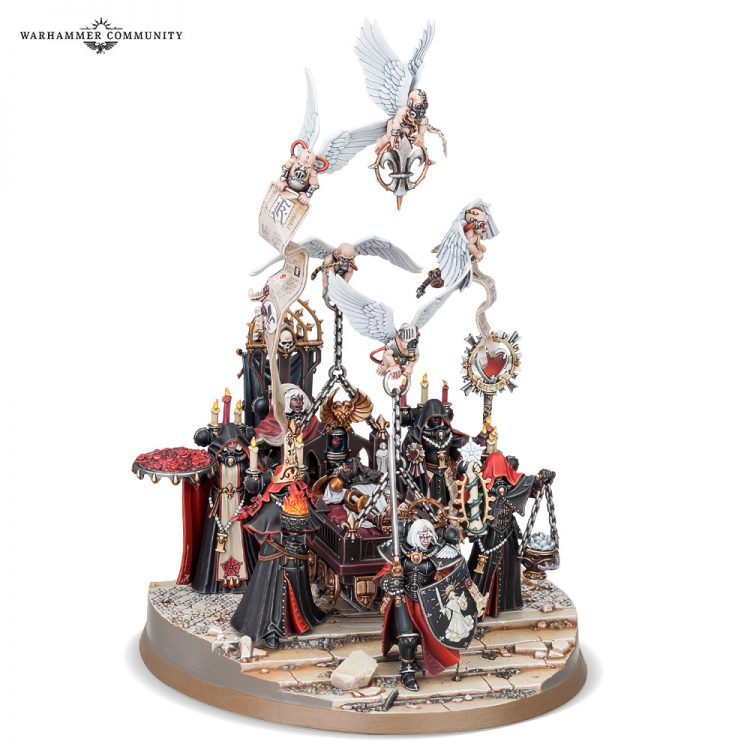
Seriously. Just look at the damn thing. Normally for a new important kit we’d have two or three painted ones in the media library, but for some mysterious reason they haven’t turned up yet. Curious. Very curious.
If you do want to see an awesome range of painted ones, Warhammer Community did an awesome article showcasing them, but that’s not what we’re here to focus on today (though you should take a look at HTPE: Sisters for ideas if you’re working on the army). The Triumph’s rules are just as unique as the model, which makes evaluating it in a vacuum pretty tricky – we thought it looked good out of the book, but there was a sufficient lag on the kit being available that people had only just started having them painted before the lockdown kicked in, so there isn’t that much data out there.
Luckily, in my capacity as your intrepid roving competitive reporter I’ve managed to get just that bit more of a read on it prior to tournaments closing down. At Battlefield Birmingham I was lucky enough to get paired against the current ITC #1 Sisters player Matt Robertson wielding a new iteration of his melee-heavy build including the Triumph (which you can check out over on 40kstats), and got to see for myself what it can do on the tabletop in a competitive setting. The good news for anyone who’s got one of these waiting for them in their pile of shame backlog is that I was pretty impressed – it definitely felt like it pulled its weight, and seemed an especially good complement to the melee units that have proven an early winner out of the book.
(As a side note, if top competitive players would like to consistently bring builds that I want to see in action to games against me that would be swell. I have a list.)
Today we’ll have a detailed look at how the Triumph works on the table, have a look at the key tricks that it enable then close by talking about some of the weaknesses you need to be careful of. Before reading on, if you’re not familiar with Sisters at all it’s probably worth taking a look at our Start Competing guide for the faction. Otherwise, it’s time to dive right in.
The Rules
The Triumph is a 185pt HQ unit with some of the most unusual rules in the game, representing as it does a group of six senior Sororitas working together and bearing a suite of ancient relics.
The basic combat stats of the model are the same as Celestians – it’s got a 6″ move, WS/BS 3+ and S/T 3. Wounds is where things take a turn for the strange – the Triumph sports a massive eighteen, protected by a 3+ save, 4+ invulnerable save and a built in -1 to hit against shooting from the fancy shield held up the front.
The final part of the basic stat block is attacks, which are on a diminishing profile. You start off with 14, and lose some when you drop to 9 or fewer wounds then again at 4. The weapons you have to go with these are pretty decent – you can make four with The Martyr’s Sword at S6 AP-3 D2, and the rest at S5 AP-1 D1. These aren’t the kind of stats that can compete with Smash McSmashwolf, but they’re enough to at least hurt anything that gets in a fight with it, and punish chaff infantry that try to wrap it. They also have six bolt pistols to help with the same, and have apparently also secreted frag and krak grenades among their ancient treasures for emergencies (or maybe to fob off particularly annoying people who want to touch the relics).
Closing out their statline, they’re both a CHARACTER and INFANTRY (the latter meaning they can claim cover if any part of the base is on appropriate terrain), but can’t ride in a transport because, again, just look at the damn thing. Because of their number of wounds, they can also be shot at as normal. They have the standard Sisters special abilities (Acts of Faith, Shield fo Faith, Sacred Rites), and can benefit from most stratagems (a few specifically exclude them) that benefit Adepta Sororitas units, but don’t have an <ORDER> tag, so lose out on quite a few auras. Lastly before we delve into their most unusual tricks, they pack a 6″ fearless aura, which can help for full squads of Repentia, Seraphim, or Zephyrim in a pinch (most other units tend to be small).
All of this is fine but none of it would make you want to bring this unit in an army. That part comes from their final set of abilities, five special effects that flow from the relics they bear. These form part of the degrading profile – at the start of the game all five are active, but if you hit nine wounds you have to choose and lose three, keeping two, and if you get as low as four you only get to keep a single one active.
The abilities are:
- Gain a miracle dice at the start of each turn (so your opponent’s too).
- A chance to do mortal wounds to nearby enemies (especially PSYKERS and CHAOS units) at the start of the shooting phase.
- Aura of +1 to hit in the Fight phase.
- Allow a unit within 6″ to perform an Act of Faith once per phase even if you’ve already used one.
- Increase/decrease the value on one miracle dice used by 1 (to a max/min of 6/1) when performing an Act of Faith for a unit within 6″. This can’t be stacked with other abilities that modify a miracle dice.
These abilities are at the core of why this unit is good, and how to use them most efficiently (and indeed which ones to lose in a pinch) is what we’re going to be focusing on.
How to Use It
At its core the Triumph is a buff engine that’s fantastic at doing two things:
- Defending your key units.
- Helping you lock in your key charges on an alpha strike turn.
It achieves this through the massive upgrades it provides to the Act of Faith mechanic through three of the five relic abilities.
Let’s get out of the way first what you probably shouldn’t try and do with the Triumph, which is “use it as a blunt instrument”. The combat stats are at best OK. Thanks to its own aura it does hit on 2s, and has a lot of attacks, but the majority of them are single damage and it doesn’t have too many ways of getting access to re-rolls. As a rule of thumb, it sits in the range where it can chew up units that aren’t good at fighting, but isn’t something you want in a throw down with a dedicated melee unit. The only mild exception to this is enemy PSYKERS, where use of Suffer Not the Witch for full wound re-rolls can throw a pretty good punch (as well as hurting them in the shooting phase with its aura). You still don’t want to be trying to rampage with it, but if a couple of Grey Knight strike squads drop in too close you can give them a nasty shock.
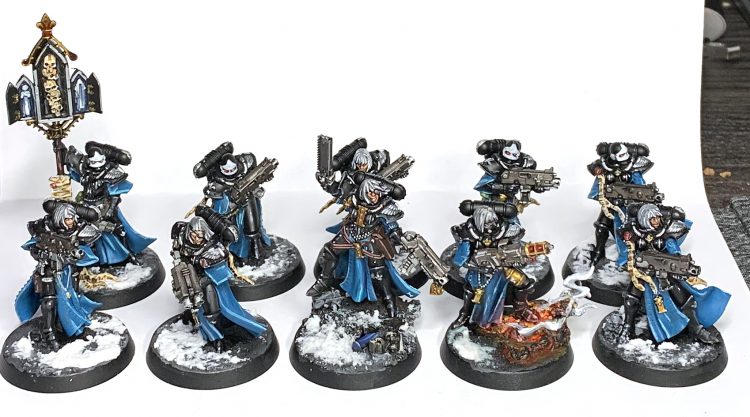
In terms of pure damage output, what it does do a bit better is amplify the rest of your units. In shooting matchups you’re likely to need to send your forces out and away from it, but in games against other melee armies the +1 to hit aura is a decent bit of defensive force multiplication, making dedicated melee units even more deadly and allowing basic Sisters and Seraphim from the Order of the Bloody Rose to hit a bit harder. The buff also works on Mortifiers, helping to mitigate the lack of the Zealot ability. This does, ultimately, still work out more like a defensive ability than an offensive one, but lets you launch a counterattack that really stings.
The other important thing to say about the Triumph is that you can’t afford to be too precious about it dying. While it does have some neat tricks on the defence (as we’ll see in a second) it is, ultimately, a massive T3 unit that can’t hide behind anything smaller than a NOVA L (and even behind big buildings the tip of the top cherub is a serious risk, as I profitably discovered in my game against it). It’s easy to get into the mindset of expending lots of effort to defend a unit that feels like it’s a centrepiece, but you have to remember that it’s only 185pts. Don’t be stupid with it, but accept that if it dies it dies. Instead, focus on getting the most value out of it while it’s on the board.
With that in mind let’s move on to the real spice: the miracle manipulation. Acts of Faith is one of the most powerful abilities in the game by itself, and the Triumph really takes it up to 11. First of all, it gives you the most reliable stream of dice available, ensuring you start the game with at least two and ensuring you never go into an opponent’s turn completely empty. This makes it a great combo with the Litanies of Faith relic on a cheap Canoness, giving you more chances to get value from the re-rolls that offers.
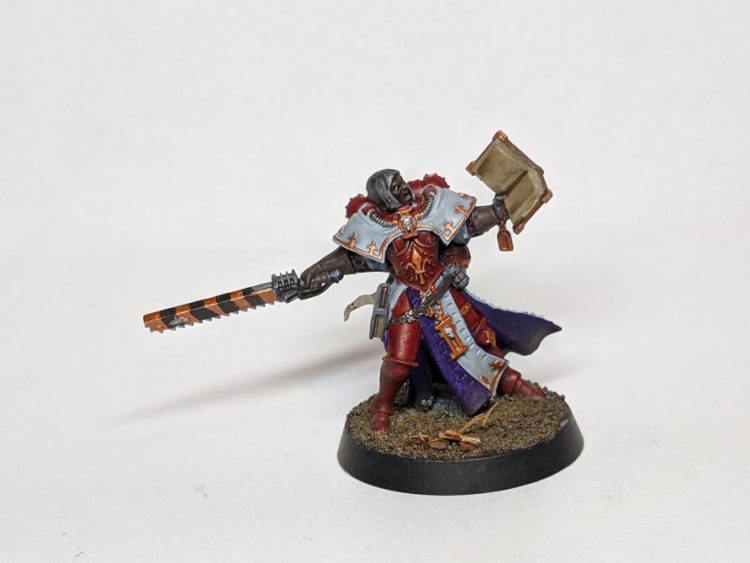
Once you’ve got the dice you need to use them, and the Triumph has got you covered there as well. The baseline rate at which you can use Acts is one per phase, but with the Triumph around you can use two per phase, both of which can potentially have +1 to the roll. The former ensures you can actually chew through the pool you build up, while the latter makes the range of dice you can get useful mileage out of much larger. All cool on paper, but the question then becomes what the best things you can do with those Acts of Faith are.
My conclusion from playing against it is two things: pass saves and guarantee charges.
Being able to chuck (potentially) two Miracle dice a turn at saving throws, both with a +1 on them, is huge. For a start, it does a good amount to help the Triumph’s own survivability. It can benefit from all of its own boosts, and has a 4++, so any miracle dice in your pool that’s showing a 3+ can be used for an automatic save, up to twice a phase in a pinch! That’s a pretty hefty discouragement to enemies planning to throw lascannon shots at it; the -1 to hit and 4++ make it faintly dicey anyway, and it gives you a great way to squeeze value out of 3s in your pool, which aren’t as useful for other things. It’s especially good to do this if it makes the difference between dipping down a wound bracket or not.
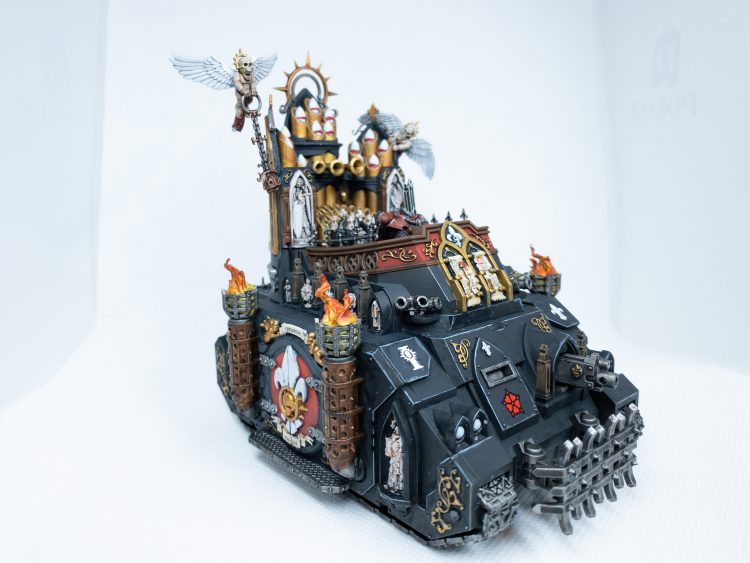
While it needs better dice, the save capability is also great for protecting transports full of Repentia, as with their 6++ from Shield of Faith you can auto-shrug anything with a 5 if the Triumph is nearby. The Robertson list functions by pushing some Rhinos filled with Repentia up mid board, seizing control of objectives and threatening to fire out devastating charges at anything that dares come too close, and using pressure from Zephyrim and (in some variants) Seraphim to force the issue if the opponent hangs back. The key potential weakness of this strategy is how quickly Repentia melt to anti-infantry fire (especially indirect) if the Rhinos go down, and being able to call on the Emperor’s blessings to help at least one of the tanks through an alpha strike and into a hidden position behind terrain can make a big difference to how the game plays out from there.
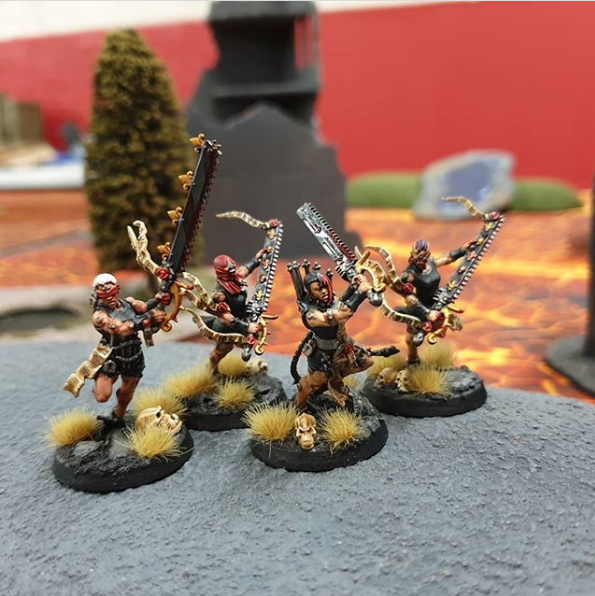
Now let’s talk about these devastating charges. Bloody Rose Repentia and Zephyrim have emerged as some of the best damage dealers in the Sororitas book, and being able to use Acts of Faith to guarantee charges for them (after long advances, in the case of Repentia via Holy Rage) is a big part of this. The constraints on this are the number of dice needed, the rate at which you can use Acts and needing decent values from the pool to land stuff and wouldn’t you know it, the Triumph takes the limiters off pretty much all of these.
Turns 2 and 3 are likely when you’re going to want to do big stuff, as it’s when you can bring in your deep strikers and also when your opponent is likely a bit closer to where your Repentia start. How much of a difference the Triumph makes can probably best be illustrated with an example.
Let’s imagine that it’s turn 2 and you want to ruin some smug elf chump’s day (picking an example entirely at random). You’ve got a Rhino full of Repentia chilling next to the Triumph 26″ from some Dire Avengers in one direction and some Storm Guardians in another. You’ve also got some Zephyrim in Deep Strike, and Hand of the Emperor is up (+1″ Advance and Charge).
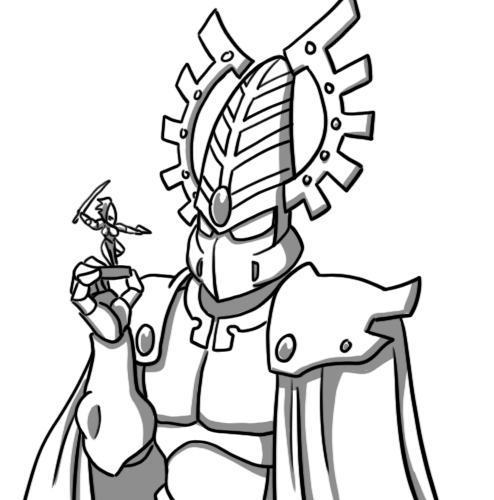
First up, let’s fire the Repentia at some Dire Avengers. You want to minimise their charge distance, so you disembark the leading one with the back of the base just within 3″ of the tank (so the front is just >4″ out with a 28mm base), and trail a model back into the Triumph’s aura. You then use a 5 from your pool and upgrade it to a 6 to get a maximum advance in with them, shooting them another 13″ towards the targets, who are suddenly just under 9″ away. Meanwhile, you drop your Zephyrim in with the front model 9″ from the Storm Guardians, and space out the rest so that at least one model is within 6″ of the Triumph.
Come the charge phase, the Repentia aren’t in the bubble any more (as you want to really maim the Dire Avengers) so you do their Act of Faith powered charge first. With Hand of the Emperor, you need a total of 7 from your pool get within an inch, which you can knock out with a three and a four. In they go, and bye bye Dire Avengers.
Without the Triumph you’d now have to trust to the Emperor (and I guess their re-roll banner) to get the Zephyrim in. Now you don’t have to take the risk – and what’s more with the combination of Hand of the Emperor and +1 to a dice from the Triumph, you only need another 7 total to get them in as well – and can even pull it off using a 6 and a 1 if you’ve got the latter languishing in your pool. Over the course of that turn, that’s two guaranteed powerful charges landed rather than one, and the set of miracle dice required to do it was way more modest than if you were using them raw. As a technical point, do be careful that if you’re planning on doing one AoF charge from a unit outside the aura and one inside you have to do the one outside the aura first – the ability lets you use an AoF on a nearby unit even if one has already been used in the phase rather than providing just a blanket “you can do two”. Don’t screw yourself on this!
While the Charge phase has been the focus here you can use the Triumph’s bonus on shooting too. I’m not convinced that in that scenario it acts as an effective enough force multiplier to make it worth it by itself, but if you’ve got a mixed shooting/melee list (as some are also trying with Valorous Heart) there are a few neat tricks you can do in a pinch. If you really, really need something dead from a shot from an Exorcist you can:
- Use a Triumph-boosted dice with Faith and Fury to land the hit and wound.
- Use the second AoF from the Triumph on the damage roll.
I don’t think this will be game changing as often as landing auto-charges or saves is, but the upside is that you can usually tell when it’s going to be, because it’s when there’s a vital vehicle sitting in your sightlines with 6W left when you’re running out of shots!
Overall with the Miracle dice, the fact that you can add one to a dice every single time adds up to a massive amount of incremental advantage as you blow through Acts of Faith. That’s part of why I wanted to put this together because I think it’s where the unit really shines and it isn’t super obvious if you don’t know what you’re looking for – the Triumph will win games via what it allows other units to do rather than pulling off big flashy stuff itself.
The last important tactical point with the Triumph is which relics to drop when it loses wounds. Unless the Triumph is about to engage in a heavy close quarters engagement the shooting and fight auras are definitely the first to go, but you have to drop one of the three miracle manipulators as well. In general, I’d suggest the following:
- If your miracle pool is low or empty, drop the ability to do two AoFs per phase.
- If your miracle pool is full of good dice drop the +/-1.
- If your miracle pool is full of mediocre dice, drop the extra dice per turn.
One final important technical point, similar to the timing on charges, is about using AoFs to save attacks on the Triumph when you’re about to go over the wound threshold and are planning to drop the two AoF ability. Because of the wording, you can’t use your “extra” Act of Faith before the ability goes away, so you either need to blow both saves before you cross the threshold, or choose a different ability to drop.
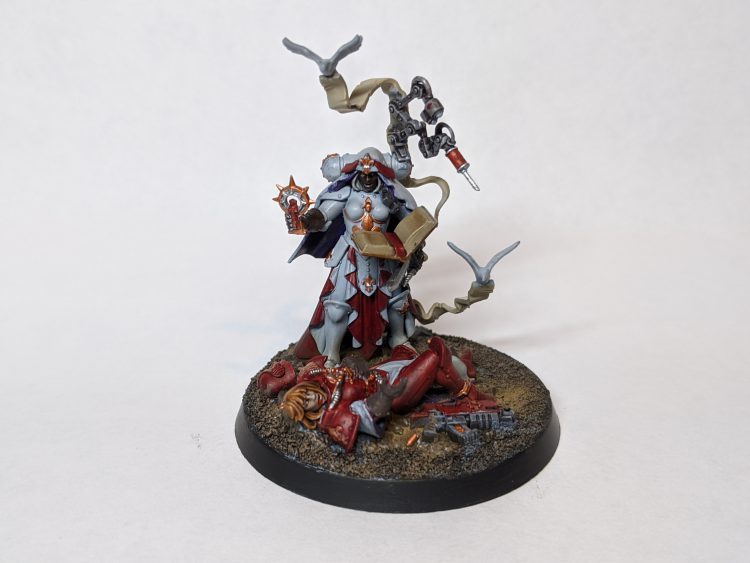
If you really like your relics, you can also heal your Triumph with a Hospitalier. These aren’t seeing a tonne of use because there aren’t many Sisters units where getting a model back up matters that much, but if you’ve decided to bring one healing the Triumph is one of the best things they can do.
Weaknesses
As you’ve hopefully seen, you should be using the Triumph in such a way that you build up value with it over time, especially for big turns on 2 and 3, making it only a modest tragedy (though obviously a massive theological disaster) if it dies at some point after that. The two big ways you can lose it in a way that “hurts” are:
- Getting it taken off the board straight away.
- Letting its odd size allow your opponent to mess around in the Fight phase.
Now obviously if your opponent has brought enough long-ranged guns and really wants the Triumph dead you probably can’t stop them – making sure it’s toed into cover will help, as will auto-saving the worst hits, but it’ll die to enough shooting. However, if it sucks up all the opponent’s big guns to do so then you probably don’t mind too much, but what you absolutely don’t want to happen is let them kill it with shooting or attacks that aren’t as much use elsewhere. Weapons like heavy burst cannons and (especially) Endless Fury are a pain for this, as the S6 D2 isn’t super efficient against anything else other than Mortifiers that Sisters tend to run, but you also need to watch out for massed anti-infantry firepower.
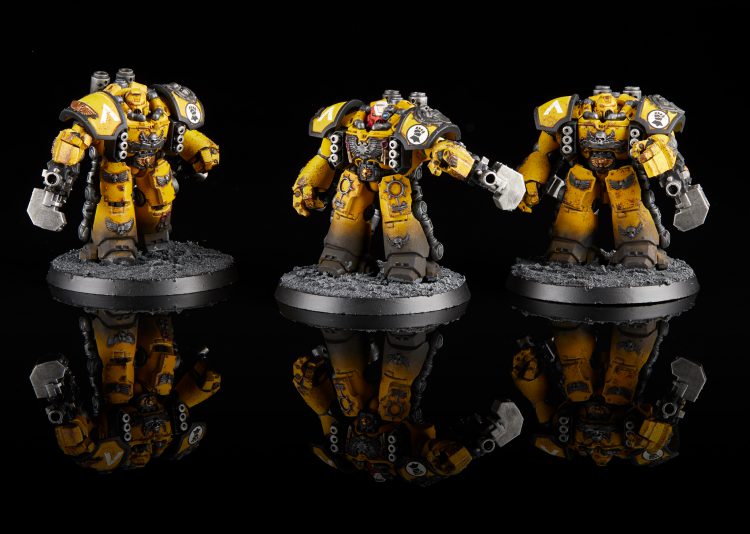
Raven Guard Centurions popping out of Deep Strike on the top of your opponent’s 2 are the worst for this – thanks to their Doctrine buff the hurricane bolters from a full squad with no additional buffs will just flat out delete the Triumph if it’s in the open, and leave it clinging to life if it’s in cover. Given that they can do this at 27″ with Long Ranged Marksmen there might not be a tonne you can do about this other than plan how to make them pay.
Making sure that the Triumph is far back enough that dropping in within range means opening up to a Repentia charge will hopefully give the Centurions pause, as even they very much do not want to catch that in the face. At that point, especially if you combine it with other charges to suppress a counterattack, the trade probably comes out in your favour – just remember to bring an Inquisitor to turn off their flamers.
Similar to this, you need to watch out for getting charged by volume melee attackers like Orks – Boyz (or probably more worryingly Stormboyz) will just go straight through the Triumph’s health pool thanks to wounding it on 3s and its lack of a 2+ save. Highly numerous units can also afford to wrap it and suck up its counter-punch – a unit starting at 30 can afford to lose 10 models if it keeps the rest in a profitable fight.
Vicious counterattacking is again the solution to this and the other potential problem with the Triumph – the big base. Normally units on a base this size are either fliers, TITANIC units that can fall out over enemies, horrific melee blenders like Discolords or multiple of the above. The Triumph just kind of isn’t any of those things, and if it get isolated is at real risk of being tri-pointed by enemy vehicles seeking to use it as a place to hunker down safely through a shooting phase. From a technical point of view, you might be able to stop them by using a heroic intervention – if they charge three units within an inch of the front “arc” of the triumph hoping to dance two of them round the sides, you might be able to use your intervention to touch all three and stop them pulling it off, leaving them dangerously exposed.
More strategically however, just make sure you have a counter-charge plan. The Triumph works best with melee units anyway, and Repentia and Zephyrim, especially in its aura and buffed by Tear Them Down are highly effective general-purpose killing machines. Make your opponent regret interfering with a holy procession
Wrap Up
The Triumph is a unit I’ve been hoping was good since the rules landed, and I’m very happy to see that it appears to have real competitive uses. If you’ve picked up this amazing model for your collection we hope you’ve now got a handle on how to use it. Doing a unit level deep-dive is something we haven’t done much before, and while the Triumph is very unique we’d be open to doing more, so let us know either in the comments or at contact@goonhammer.com if you’d like to see more like this.
